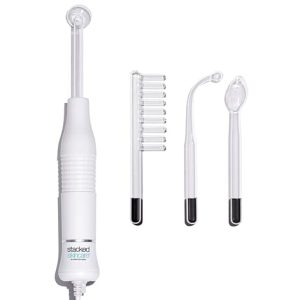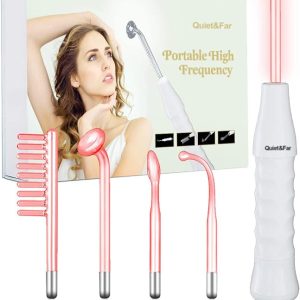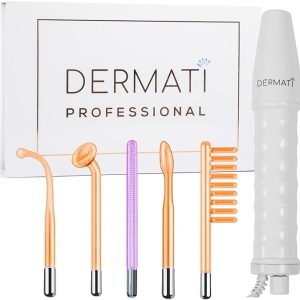Two popular options, high frequency facial (HF facial) and LED light therapy, promise impressive results but operate in different ways. But how are they different?
In this article, we’ll delve into the inner workings of HF facial and LED light therapy, exploring how they address various skincare concerns. We’ll examine the unique benefits each treatment offers, potential side effects to be aware of, and considerations for combining them in a comprehensive skincare routine.
By the end, you’ll have a clearer understanding of which approach aligns best with your skincare goals and preferences.


High Frequency Facial:
High frequency facial utilizes a low-level electrical current to stimulate the skin, promote collagen production, and enhance circulation.
This treatment is commonly used to address various skincare concerns such as acne, fine lines, wrinkles, and dullness. The benefits of high-frequency facials include:
- Reduction of acne and breakouts
- Improved skin texture
- Enhanced product absorption
- Reduction of fine lines and wrinkles
- Overall skin rejuvenation
During the procedure, a glass electrode is applied to the skin’s surface, emitting a high-frequency alternating current that generates warmth and oxygenates the skin.
The current generates oxygen molecules, eliminating acne-causing bacteria and reducing inflammation. Simultaneously, it enhances blood circulation, delivering essential nutrients and oxygen to skin cells for improved overall health and radiance. The gentle heat produced stimulates collagen production, promoting skin elasticity and reducing the appearance of fine lines and wrinkles.
LED Light Therapy:
LED light therapy is a non-invasive treatment that utilizes specific wavelengths of light to target various skin concerns.
Different colors of LED light penetrate the skin at different depths, triggering specific reactions within the skin cells.
- Blue light is used to target acne-causing bacteria, reducing breakouts and inflammation.
- Red light stimulates collagen production, improving skin texture and reducing the appearance of wrinkles.
- Near-infrared light reaches the subcutaneous tissue, stimulating fibroblast activity to further increase collagen levels and improve skin firmness.
LED light therapy is painless, safe for all skin types, and requires no downtime, making it a popular choice for addressing a wide range of skincare issues effectively. Some of its benefits are:
- Acne reduction
- Improved skin texture
- Diminished wrinkles
- Enhanced wound healing
- Reduced redness and inflammation
- Overall skin rejuvenation
Difference Between Hf Facial & LED Light Therapy:
| Aspect | LED Light Therapy | High Frequency Facial |
|---|---|---|
| Technology used | Targets specific skin concerns using different wavelengths of light | Utilizes low-level electrical current to address various skin issues |
| Application Method | Light-emitting diode (LED) devices are placed close to the skin, emitting specific wavelengths of light. Treatment duration varies depending on the specific skin concern and device used. | A glass electrode connected to a high-frequency machine is gently applied to the skin’s surface, delivering a low-level electrical current. Treatment frequency and duration depend on the skin condition and treatment plan. |
| Frequency of Usage | Typically used multiple times per week, depending on the specific treatment plan. | Can be used 1-3 times per week, depending on the skin condition and treatment plan. |
| Result Time | Results may vary, but noticeable improvements can often be seen after several weeks of consistent treatment. | Immediate results may be visible, with cumulative improvements over time with regular use. |
| Effects | – Reduces acne and breakouts – Improves skin texture – Diminishes wrinkles – Enhances wound healing – Reduces redness and inflammation – Promotes overall skin rejuvenation | – Kills acne-causing bacteria – Improves blood circulation – Stimulates collagen production – Enhances product penetration – Promotes skin rejuvenation |
| Better for Which Condition | – Acne reduction – Wrinkle reduction – Overall skin rejuvenation | – Acne treatment – Improving blood circulation – Enhancing collagen production – Promoting product penetration |
Potential Side Effects of LED Light Therapy:
Potential side effects of LED light therapy include:
- Mild Irritation: (usually resolves within a few hours)
- Dryness or Flakiness: (In rare cases)
- Photosensitivity: (Rare, It’s essential to use sunscreen)
Potential Side Effects of HF Treatments:
The potential side effects of high frequency facial (HF facial) are generally rare and mild. However, they may include:
- Skin Irritation: (resolves on its own within a few hours)
- Dryness or Flakiness: (Temporary)
- Breakouts: due to the purging of toxins and bacteria from the skin and should resolve with continued treatment)
- Sensitivity: (discomfort or irritation during the treatment)


Which Is Better, LED Light Therapy or High Frequency?
Choosing between high frequency facial (HF facial) and LED light therapy depends on individual skincare needs.
HF facial is ideal for acne treatment, improving blood circulation, and promoting collagen production
While LED light therapy targets specific concerns like acne reduction, improved skin texture, and overall rejuvenation.
Both are safe and effective, with HF facial utilizing electrical currents and LED therapy employing specific light wavelengths.
Can I Use LED Light Therapy and High Frequency Together?
Yes, LED light therapy and high frequency treatments can be used together in a skincare regimen. Combining these treatments can provide complementary benefits, as they target different aspects of skin health.
LED light therapy addresses specific skin concerns using various light wavelengths, such as acne reduction and overall skin rejuvenation.
On the other hand, high frequency treatments utilize electrical currents to improve blood circulation, stimulate collagen production, and enhance product penetration.
Which Treatment Is Less Painful?
In general, LED light therapy is considered less painful compared to high frequency treatments.
LED light therapy is also non-invasive and does not involve the use of heat or electrical currents, making it a painless and comfortable experience for most individuals.
On the other hand, high frequency treatments may cause a mild tingling sensation or discomfort due to the application of low-level electrical currents to the skin. However, both treatments are generally well-tolerated, and any discomfort experienced during high frequency treatments is typically minimal and temporary.
Ultimately, individual pain tolerance may vary.
Conclusion:
In conclusion, both high frequency facial (HF facial) and LED light therapy offer effective solutions for various skincare concerns. HF facial uses electrical currents to stimulate collagen and circulation, ideal for acne and texture improvement. LED therapy targets specific issues with light wavelengths, like acne reduction, in a painless manner.
While both are beneficial alone, combining them can provide comprehensive skincare benefits.
Ultimately, the choice depends on individual needs, with both treatments offering safe and effective options for achieving healthy, radiant skin.






